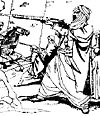
Arab chroniclers of the period -- that is, those whose works have come down to us -- are generally silent about what one Western historian called this "strange Islamic State encapsulated within a wholly Christian land." Perhaps they did not regard it as sufficiently important, compared with the momentous events then taking place in the Iberian Peninsula.
At that time, the Umayyad dynasty of al-Andalus, which had ruled Spain for scarcely a century, was being challenged from all directions. Revolts were underway in scores of Spanish cities, some led by Arabs, some by North African Berbers, and others by muwalladun, or Muslims of Spanish stock. The Umayyad ruler Abdullah, an educated, pious man who lacked political skills, struggled desperately to maintain his realm, but by 912 the amirate had virtually disintegrated, and Abdullah controlled little beyond the walls of his capital, Cordoba.
In that year, he was succeeded by his talented grandson Abdul Rahman III, who was destined to become one of the greatest leaders in the history of Islamic Spain. Over the coming years Abdul Rahman would end the rebellions, establish a caliphate in al-Andalus, and preside over a "golden age" of prosperity that saw Cordoba become the leading intellectual and political center of Europe.
All this occurred while Andalusi Muslims, building on a minor raid in Provence were gradually extending their control into neighboring areas of France, northern Italy and even Switzerland. But if Muslim historians are silent, the Europeans whose lives were so disrupted by these events left records of the original incursion and its aftershocks, and from them we can reconstruct the story.
One of the most detailed accounts comes from Liudprand of Cremona, a 10th century Italian bishop and diplomat. He described the 20 men who launched the second Arab invasion of France as "Saracen pirates"; they might have described themselves as adventurers. Their identities are lost to history. They may have belonged to a Spanish Muslim faction that had lost an internecine power struggle in al-Andalus, and were looking for unclaimed lands to conquer. Or they may have had a formal link with the Umayyad government at Cordoba, operating under the Muslim equivalent of a letter of marque, with official authority to raid Frankish lands. Liudprand suggests the latter stating that the base they eventually established in southern France operated under the protection of Abdul Rahman III and in fact paid tribute to him.
Tempting Riches of Provence
The raiders were attracted to a region with great natural appeal. The French coast from Marseilles to Italy, with its rocky headlands and lush, wooded coves, studded with palm trees and brilliantly colored flowers, must have been as alluring to Muslim adventurers of the ninth century as it is to travelers today. Indeed, according to the 17th century Arab historian al-Maqqari, some Muslim authors of earlier times believed that the French would be barred from Paradise, because they had already been blessed by their Creator with a paradise on earth: fertile lands abounding in fig, chestnut and pistachio trees, amid other natural bounties.
The raiders arrived in Provence in about 889, at a time of great confusion and misery. Just 30 years earlier, France's southern coast had been plundered and pillaged by Norse pirates. Entire towns were leveled, and many local inhabitants were put to the sword. Duke Boso of Lyons, a usurper related by marriage to France's ruling Carolingian dynasty, took advantage of the chaos and, with the support of local counts and bishops, set up his own breakaway kingdom in Provence in 879. The Carolingian kings could not evict him. When Boso died in 887, his son and heir, Louis, was too young to rule effectively; local lords and princes began asserting their independence and challenging one another. The Carolingian empire was splitting into western and eastern Frankish kingdoms. There was no central authority along the southern French coast, and Provence was ripe for the plucking.
Arab freebooters struck often along these shores. Just as in later centuries British privateers -- pirates -- often worked hand-in-glove with the Royal Navy, so Andalusi corsairs plied the western Mediterranean in the sympathetic shadow of a large Muslim naval fleet, built up by the Umayyad government only a few decades before in response to the Norse raids that also struck the coasts of al-Andalus.
The 20 Muslim corsairs set sail from a Spanish port, intent on raiding an unknown target to the east. Stormy weather forced them to retreat --"unwillingly," Liudprand says -- into the Gulf of St. Tropez, where they beached the craft without being spotted. The gulf opens toward the east; the present-day fishing port of St. Tropez, fashionable vacation spot of artists, film stars and the well-to-do, is situated on the southern shore.
The pirates landed northwest of there, and, drawn by the torch lights of the manor house, headed up the mountain ridge known as the Massif des Maures. Some say the ridge takes its name from the invading Arabs, who were also known as Moors; others claim it derives from a Provenšal corruption of the Greek word amauros, meaning dark or gloomy -- an apt description of the mountain's thick forests of cork oak and chestnut.
Before sunrise, the pirates attacked and captured the manor house and secured the surrounding area. When dawn finally broke they could see, from the heights of the massif, towering Alpine peaks to the north, thickly forested slopes below, and the broad blue expanse of the Mediterranean to the south.
More The Pirates of St. Tropaz
-
Introduction
An Islamic State?
Occupiers
William of Arles
9th Century Mediterranean Map (Large: slow: 184K)
9th Century Mediterranean Map (Jumbo: Monstrously slow: 498K)
Back to Cry Havoc #35 Table of Contents
Back to Cry Havoc List of Issues
Back to MagWeb Master Magazine List
© Copyright 2001 by David W. Tschanz.
This article appears in MagWeb (Magazine Web) on the Internet World Wide Web. Other military history articles and gaming articles are available at http://www.magweb.com